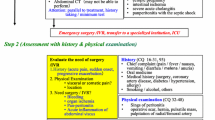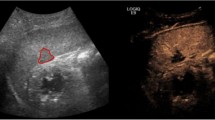Abstract
The aim of this study is to present the outcome of operative and non-operative management of patients with liver injury treated in a single institution depending on imaging. This study was conducted at the Causality Unit of Minia University Hospital, and included 60 patients with hepatic trauma from March 2012 to January 2013. In our study, males represent 80 % while females represent 20 % of the traumatized patients. The peak age for trauma found was 11–30 years. Blunt trauma is the most common cause of liver injury as it was the cause in 48 patients (80 %). Firearm injuries are the most common cause of penetrating trauma (60 %) followed by stab injuries (40 %). More than one half of our patients (34 out of 60) were treated with non-operative management (NOM) with a high success rate. The operative procedures done were suture hepatorrhaphy (20 cases), non-anatomical resection in one case, anatomical resection in one case, and damage control therapy using pads in two cases. In another two cases, nothing was done as subcapsular hematoma had resolved. Minia University Hospital is a big tertiary Hospital in Egypt at which blunt liver trauma is more common than penetrating liver trauma. Surgery is no longer the only option available. It has been reserved for extensive lesions with condition of hemodynamic instability or for the treatment of the complications. NOM is an effective treatment modality in most cases.
Similar content being viewed by others
References
Helling TS, Ward MR, Balon J (2009) Is the grading of liver injuries a useful clinical tool in the initial management of blunt trauma patients? Eur J Trauma Emerg Surg 35:95–101
Gourgiotis S, Vougas V, Germanos S (2007) Operative and non-operative management of blunt hepatic trauma in adults. J Heptobiliary Pancreat Surg 14:387–391
Gakwaya AM (2004) Blunt liver trauma in Mulago Hospital. East and Cent Afr J Surg 9:85–88
El-Gamal A, Labib H, Hussein HM, Petkovska J, Daouk Z, Al-Awadi N (2004) Liver injury after blunt abdominal trauma: role of nonoperative management. PAN Arab Med J 25:51–55
Iqbal P, Sial K, Iqbal SA (2000) Liver injuries: management and outcome. Med Channel 6:27–32
Ali U, Noor A, Shah M, Alam W, Noor A (2008) Trauma management in a tertiary care hospital in Pneshawar, Pakistan. J Med Res 20:112–115
Ahmad N, Abid KJ, Khan AZ, Shah ST (2001) Management of penetrating liver injuries. Ann Surg 07:293–295
Brammer RD, Bramhall SR, Mirza DF, Mayer AD, McMaster P, Buckels J (2002) 10 years experience of complex liver trauma. Br J Surg 89:1532–1537
Llado L, Jorba R, Pares D, Borobia FG, Biondo S, Farran L, Fabregat J (2002) Influence of the application of a management protocol in the treatment of blunt abdominal trauma [abstract in English]. 72(2):79–83
Markogiannakis H, Sanidas E, Messaris E, Michalakis I, Kasotakis G, Melissas J, Tsiftsis D (2006) Management of blunt hepatic and splenic trauma in a Greek level I trauma center. Acta Chir Belg 106:566–571
David Richardson J, Franklin GA, Lukan JK (2000) Evolution in the management of hepatic trauma: a 25-year perspective. Ann Surg 232:324–330
Velmahos GC, Toutouzas KG, Radin R, Chan L, Demetriades D (2003) Nonoperative treatment of blunt injury to solid abdominal organs: a prospective study. Arch Surg 138:844–851
Demirel AH, Basar OT, Ongoren AU, Bayram E, Kisakurek M (2008) Effects of primary fibrin sealant on hemostasis suture and liver regeneration in an experimental liver injury. World J Gastroentrol 14:81–84
Vatanaprasan T (2005) Operative treatment of hepatic trauma in Vachira Phuket Hospital. J Med Assoc Thai 88:318–328
Demetriades D, Hadjizacharia P, Constantinou C, Brown C, Inaba K, Rhee P, Salim A (2006) Selective nonoperative management of penetrating abdominal solid organ injuries. Ann Surg 244:620–628
Bismar HA, Alam MK, Al-Keely MH, Al Salamah SM, Mohammed A (2004) Outcome of nonoperative management of blunt liver trauma. Saudi Med J 25:294–329
Acknowledgments
The authors would like to offer their sincere thanks to all patients and their relatives.
Author information
Authors and Affiliations
Corresponding author
Ethics declarations
The title, aim, and plan of the study were discussed and approved regarding ethics of research in the General Surgical Department, Minia Faculty of Medicine. Full written and informed consent was obtained from all relevant participants.
Conflict of Interest
The authors declare that they have no competing interests.
Statistical Analysis
Data were analyzed using SPSS version 16.0 (SPSS Inc., Chicago, IL, USA). Quantitative data were expressed as mean ± standard deviation, while qualitative data were expressed as number and percentage, and it was compared using chi-square and Fisher’s exact test. P value of less than 0.05 was considered to indicate significance.
Rights and permissions
About this article
Cite this article
Saleh, A.F., Al.Sageer, E. & Elheny, A. Management of Liver Trauma in Minia University Hospital, Egypt. Indian J Surg 78, 442–447 (2016). https://doi.org/10.1007/s12262-015-1393-6
Received:
Accepted:
Published:
Issue Date:
DOI: https://doi.org/10.1007/s12262-015-1393-6




